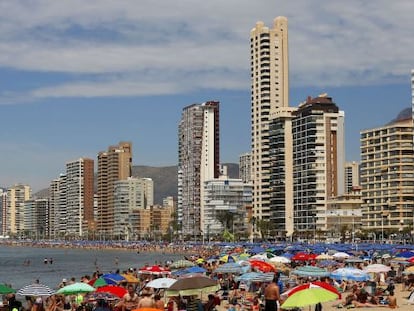Cracks appear in Spain’s low-cost tourism model
Travel may support local economies, but some cities can no longer accommodate the flood of visitors

If it lives up to expectations, 2016 will be a record year for world tourism. Right now the number of travelers who went abroad for purely recreational trips in 2015 is a record 1.184 billion. Of these foreign vacationers, Spain received 68.1 million, a figure likely to be overtaken in a matter of months. The latest statistics show that foreign tourists coming to Spain still seek out the sun, flocking to the country’s beaches. Catalonia was the most popular destination in 2015, (17.4 million people) followed by the Balearic and Canary Islands (tied at 11.6 million) and Andalusia (9.3 million). The profile of the typical tourist in Spain is British, flying into Catalonia or the Canary Islands, settling into a hotel and spending an average of €116 a day.
The tourism industry is a powerful driving force for Spain’s economy – but can it survive its own success?
The tourism industry is a powerful force in Spain’s economy, generating a wide array of jobs and substantial revenue, but the question is whether the country’s long-standing low-cost model can survive its own success. The efforts poured into attracting visitors has caused population density per square meter to exceed capacity in some areas. For example, when the monstrous “Harmony of the Seas” (a cruise ship that’s more like a floating city, able to accommodate 7,000 passengers and 2,000 crew members) suddenly descends on Barcelona, an avalanche of tourists pours down the city’s central Las Ramblas thoroughfare, packs out Gaudi’s unfinished Sagrada Familia basilica, overwhelms the Boquería market, and floods the scenic Park Güell.
The paradigm of the mass, “all-inclusive” family vacation can be found at Marina D’Or Ciudad de Vacaciones, a vast seaside complex in Oropesa, Castellón, made up of 15,000 apartments, five hotels and dozens of children’s attractions, restaurants, shops and spas. Salou (Tarragona), Lloret de Mar (Girona) and Magaluf (Mallorca) are other hugely popular destinations for travelers seeking fun in the sun washed down with cheap drinks. Given that German travel agency Tui promotes the Balearic Islands as the ideal spot to “party until the doctor comes,” it’s no surprise the islands now hold the title “ethylic excursions” attracting rowdy, disruptive crowds.
Sign up for our newsletter
EL PAÍS English Edition has launched a weekly newsletter. Sign up today to receive a selection of our best stories in your inbox every Saturday morning. For full details about how to subscribe, click here.
The combined availability of low-cost flights and accommodation have done little to counter the tourism sector’s race to the bottom, which in the long run, could frighten away visitors looking for a higher quality, more sustainable family vacation. In short, the tourism sector faces the possibility that inebriated, aggressive visitors will take over popular destinations, discouraging higher-end visitors interested in culture, art, history, or food.
In response, a number of city halls are planning to limit tourist numbers to protect their public spaces. The Canarian island of Fuerteventura, its services and resources increasingly under pressure, has set 2.5 million as the maximum number of visitors it can take per year before the island’s quality of life begins to erode.
English version by Allison Light.
Tu suscripción se está usando en otro dispositivo
¿Quieres añadir otro usuario a tu suscripción?
Si continúas leyendo en este dispositivo, no se podrá leer en el otro.
FlechaTu suscripción se está usando en otro dispositivo y solo puedes acceder a EL PAÍS desde un dispositivo a la vez.
Si quieres compartir tu cuenta, cambia tu suscripción a la modalidad Premium, así podrás añadir otro usuario. Cada uno accederá con su propia cuenta de email, lo que os permitirá personalizar vuestra experiencia en EL PAÍS.
¿Tienes una suscripción de empresa? Accede aquí para contratar más cuentas.
En el caso de no saber quién está usando tu cuenta, te recomendamos cambiar tu contraseña aquí.
Si decides continuar compartiendo tu cuenta, este mensaje se mostrará en tu dispositivo y en el de la otra persona que está usando tu cuenta de forma indefinida, afectando a tu experiencia de lectura. Puedes consultar aquí los términos y condiciones de la suscripción digital.











































